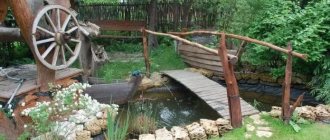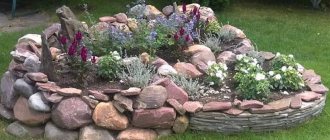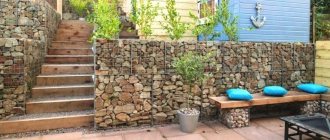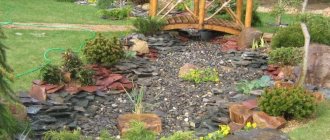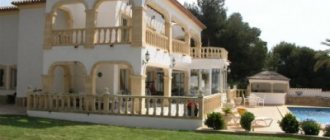There is a huge variety of garden styles and compositions. If you want to transform your dacha space and try yourself as a landscape designer, you need to get acquainted with the basics and features of each style.
Why doesn’t even an expensive and exquisite garden with rare and beautiful plants always look good? This happens because it is not designed in a single “key” or, in design language, does not have a landscape style. To understand which style is right for you, you should become familiar with the main trends in landscape design. There is no need to blindly copy proportions, a set of plants and the arrangement of elements on the site - it is enough to grasp the general directions and improvise, using fantasy and imagination. We will help you with this.
Regular style
Classic or regular style creates a feeling of solidity, order and solemnity. This style implies clear lines and strict symmetry in the layout. The main elements of the concept are considered to be the presence of open space, ponds and fountains of predominantly rectangular shape, smooth parallel or perpendicular paths, and curly trimmed evergreen bushes.
The bush looks great in the center of the flower bed, especially if it is trimmed into a ball, cone or other unusual shape. Caring for a garden in a classic style is comprehensive. Constant trimming of shrubs and mowing the lawn is required to keep the garden looking beautiful. The classic style creates the feeling that nature has completely submitted to man, and the location of every pebble and flower is carefully thought out.
Japanese (oriental) garden style
Traditional oriental gardens were intended for meditation and quiet contemplation. They served as a kind of “spiritual refuge”, so the main attention is paid to natural components. A Japanese garden should look natural and harmonious, so artificial elements cannot be found here. There is also no room or symmetry here.
The main elements of an oriental (Japanese) style garden:
- fountain, pond or stream;
- paths;
- bamboo hedges and moss;
- stones and plants;
- tree crowns shaped like hills.
The role of accessories is usually performed by the following parts:
- bridges over water areas;
- traditional Japanese gazebos (“tea houses”);
- stone benches and lanterns;
- ropes, driftwood and twisting plants;
- products made of light ceramics.
The main thing when creating the color scheme of an oriental garden is not to make sharp transitions between one color and another. There should be two or three color accents: gray, brown, sky, white.
High-tech style
This is the youngest of the landscape styles; it represents a set of design solutions that provide comfort and a minimum of garden maintenance. Modern garden style involves the use of materials such as concrete, metal, plastic, polycarbonate.
It is characterized by bright functional lighting, expressive lines, contrasting colors, and regular geometric shapes.
Asymmetry is allowed if it merges into a single picture. For lighting, façade illumination and solar-powered lamps are used. For landscaping, it is better to give preference to trees with an original crown shape and plants with rich colors.
For landscaping the site in a modern style, weeping birch, ornamental apple trees, blue spruce, barberry, and rhododendron are used. Abstract sculptures are suitable as decorative elements. As part of the modern style, ponds with a concrete or metal frame of the original shape are preferable.
English style
The traditional English or landscape garden style has its roots in British culture. A site arranged in this manner is full of alluring charm.
The main task of the English style is to imitate the natural landscape. The style is characterized by asymmetry; the main features of this style are vertical gardening, a neat lawn, the absence of strict geometry, winding paths, benches made of natural materials, tall and shady trees.
A small pond with aquatic plants and a weeping willow is desirable. The style does not imply straight lines and outlines, figuratively trimmed trees and symmetrical paths. Its task is to preserve the naturalness of the plantings. Style dictates the selection of plants that grow well without direct sunlight. These are bright primroses, roses of different shades, violets, forget-me-nots, rosemary, verbena.
Choosing plants in a formal garden
The concept of the French regular style in garden design is based on strict geometry, and therefore plants for such gardens are selected so that they are well trimmed, easily take the correct shape, and are resistant to disease.
First of all, these are evergreen species that can look well-groomed and attractive throughout the year. In gardens of the French regular style you can often see monogardens - areas in which plants of the same species are cultivated, which determines the name of the monogarden: it can be a rose garden, an iridiary, a sirengarium, etc. It is impossible to imagine a “French garden without topiaries - figuredly trimmed trees and shrubs. Also obligatory elements for it are parterre lawns and parterre flower beds or, as they are also called, arabesque flower beds.
To form smooth and neat borders, yew and boxwood are usually used. Boxwood is easy to trim and is capable of maintaining even the most bizarre shapes for a long time. Yews are famous for their exceptional longevity, have dense crowns with whorled branches, love moist air, good sunlight and fresh soil saturated with lime.
Of the shrubs, first of all you should pay attention to privet, which is represented by both deciduous and evergreen shrubs. As a rule, they are sun-loving, grow well on ordinary garden soil, perhaps even with the addition of lime, but have difficulty withstanding wet, heavy clay with an acidic reaction. In French regular style gardens, it is preferable to plant common privet - a deciduous, densely branched shrub up to 5 m high, growing quickly and able to withstand temperatures down to -30°C in winter.
The second place in popularity among plants for gardens of the French regular style, adapted to Belarusian realities, is occupied by small-leaved linden (or cordate linden) - the most resilient representative of broad-leaved species. This plant can tolerate frosts down to -48°C in winter. The maximum possible growth level for the small-flowered linden is 30 m. It has a compact oval crown and a slender cylindrical trunk. Linden is shade-tolerant, not too demanding on soil quality, but does not tolerate drought. It grows relatively quickly and is ideal for forming a hedge.
Non-thorny shrubs such as cotoneaster would also look quite appropriate in a French regular style garden. In landscape design, more than eighty types of hedges are traditionally used to form hedges.
It is impossible not to mention the common barberry, to which people gave the name “candy tree” for the pleasant delicate aroma of ripe berries. But in fact it is a thorny deciduous shrub. Forming a barberry hedge can take quite a long time - at least six years, but all the efforts will be justified in the end. In spring, the bushes are covered with golden flowers, in autumn they attract attention with the bright purple leaves. Among the varieties with intense lateral branching that are optimally suited for the formation of hedges and borders, in addition to the common barberry, it is necessary to note the Thunberg barberry, Siberian barberry and Ottawa barberry.
Of the trees, in addition to the already mentioned and extremely popular linden, in the French regular style garden you can plant maples of the campestrie type, a typical representative of which is the field maple, as well as ornamental apple trees and ornamental plums.
The field maple has a spherical crown and reaches a height of 15 m. The maple is shade-tolerant, resistant to drought and can withstand slight soil salinity. It grows quite slowly, but easily tolerates transplanting and cutting. As for ornamental apple trees, the most popular varieties adapted to the climatic conditions of Belarus are, perhaps, “Royalty” and “Everest”. 'Royalty' has red-purple leaves, bright pink flowers and small dark red fruits. This apple tree is light-loving and frost-resistant, blooms, as a rule, no earlier than May, and reaches a height of 4-6 m. “Everest” has dark green, oval leaves, white flowers, a conical crown shape with drooping shoots. The yellow-red fruits of "Everest" look very decorative and may not fall until December. The tree is resistant to frost, but does not tolerate heat at all. The ornamental plum has a dense crown with shiny purple-red leaves, grows on fertile loams of medium humidity, preferring brightly sunny places. Can be used both in group and single plantings.
Coniferous plants in gardens designed in the traditions of the French regular style are rather an exception to the rule, but in cases where climatic conditions do not allow planting it with the necessary deciduous species, and you really want to have such a garden, experiments with conifers are not forbidden. The most suitable decorative forms are gray spruce (there are about 20 of them in total), prickly spruce, thuja and cypress trees.
Unpretentious and flexible to any design experiments, thuja occidentalis has gained fame as a universal landscaping product. It also does not contradict the canons of the French regular style. Landscape designers know more than twenty varieties of thuja occidentalis, and among them they often give preference to the variety “Brabant” - a plant with green shoots and yellow tips and dynamic growth rates - up to half a meter per year. The maximum height of the thuja variety "Brabant" rarely exceeds 8 m. Two crown trimmings are enough to turn it into an impenetrable wall.
The thuja variety "Smaragd" has a beautiful cone-shaped crown and bright green needles that retain their rich color all year round. It usually grows to 1-2 m in width and up to 8 m in height, just like the thuja variety "Brabant". Thuja “Smaragd” does not tolerate waterlogging, and this care feature must be taken into account. Speaking about the selection of plants for a French regular style garden, it is worth mentioning such a variety of western thuja as the dwarf “Danika” - a spherical shrub up to 0.6 m high. It maintains the correct spherical shape throughout its entire life period, requiring no pruning at all.
Parterre lawns
Parterre lawns (link to article) in French regular style gardens should be covered with an even, silky and thick grass cover, reminiscent of a soft fleecy carpet. This surface is created by low narrow-leaved grasses - red fescue, meadow grass, bentgrass. Either one type of grass is sown, or a mixture of two different types capable of forming a homogeneous grass stand. You will have to cut it up to twice a week so that the grass does not grow higher than 1 cm.
When arranging parterre flower beds and regular arabesque flower beds, flowers must be selected so as to ensure continuous flowering throughout the season. In early spring, bulbous plants - narcissus, tulip, crocus, scylla, as well as early flowering perennials - for example, liverwort and anemone will be appropriate for them. Flowers for summer: viola, daisy, aquilegia, iris, alyssum, marigold, calendula, petunia, salvia, and many others. In autumn, the splendor of regular flower beds and flower beds will be emphasized by roses, helenium, asters and dahlias.
Mediterranean style
The style reflects Mediterranean culture and combines elegant details with elements of nature. This style is inspired by Mediterranean landscapes.
For landscaping, citrus fruits, grapes, succulents, lavender, sage, and rosemary are used. The garden is decorated with gazebos covered with climbing plants.
All details work to enhance the relaxing atmosphere. Like Mediterranean cuisine, the garden style is also a mixture of Southern Italy and the dry regions of Spain. Integral details include gravel paths, terracotta pots, ceramic tiles and a comfortable seating area.
Russian estate - reading traditions
The design of the territory is carried out on the basis of the rules of architecture and landscaping that existed approximately 200 years ago in Russia. The center of the plot is a wooden house with a porch. A wide path or alley leads to it from the gate itself to the steps. In front of the house there are flower beds with roses, daisies, chrysanthemums and other flowers that have been available and popular in Russia for a long time. Behind is a seating area. There are gazebos and arches decorated with climbing plants. Tea parties and feasts were previously held in the backyard.
Russian style in landscape design has elements that are not found in others:
- bathhouse (basic attribute, you can create a dummy, but it is better that it is working);
- well (with a wooden canopy decorated with flowers);
- cellar (canned food, vegetables are stored in it, drinks are cooled).
The Russian garden is not only beautiful, but also functional. Everything is simple and concise, cozy and harmonious.
Dutch style
This style is directly correlated with the nature of Holland and its landscape. The Dutch were forced to conquer every piece of land from the sea, so their gardens are very small.
This style is associated with tulips, mills and canals. Essential features of the Dutch style are careful zoning.
In addition, ordinary trees are replaced with dwarf trees, perfect order is maintained on the territory, every square meter of the site is used to the maximum. Bright color accents, original garden figures and art objects are also used to decorate the garden.
Minimalist style
A garden in this style is laconic and expressive in its simplicity. This is perhaps one of the most complex styles, mainly because it uses a minimal number of components that can convey so much.
Minimalism does not tolerate pretentious textures of materials, color elements should not be bright and conspicuous, garden paths should be smooth with accentuated contours. When choosing plants, it is better to give preference to cypress, thuja, maple, and juniper. Flowers in ceramic or concrete containers of strict geometric shapes will fit organically.
Garden furniture should also be decorated in a minimalist style. This could be simple lightweight aluminum or plastic furniture.
Colonial Landscape Design
Colonial style dates back to the time when Europeans arrived in America and had to re-adapt not only to a new way of life, but also to a different climate. The style combines two different cultures: the colonialists and the aborigines.
The diversity of local flora and the multinationality of the colonialists led to a striking style, which is characterized by comfort and slight carelessness. Characteristic elements of a colonial garden: clear zoning, stone paving stones, sundials, fountains, symmetrical straight gravel paths between flowerbeds, a low white fence.
The obligatory gardening part of the site in the colonial style is an echo of how the first settlers, in addition to the decorative purpose, also attached practical significance to the garden.
Story
In the middle of the 16th century, new gardens were laid out on the slopes of Boboli Hill in Florence, at the residence of the Medici Dukes. They were cherished for a long time, embodying time-tested aesthetic theses and completely new ideas. For example, thanks to specially equipped elevations, for the first time in the history of landscape art, a view of the city opened from the park.
Florentine gardens became the quintessence of everything that not only gardeners, but architects and sculptors had created before. There were wide gravel alleys and long axial paths, oaks, cypresses, lemon trees in tubs, roses and lilies in huge flower beds... And also an amphitheater, where opera arias were heard for the first time in the world, colonnades and terraces, man-made ponds with islands, fountains and grottoes, artifacts from Greece and ancient Egypt.
It was impossible not to notice the Boboli Gardens. Andre Le Nôtre, a hereditary master of landscaping, court gardener of Louis XIV (it is known that the French monarch was very keen on the art of gardening), created a project for the Versailles park, taking the Boboli gardens as a basis.
The style that emerged as a result stunned and captivated Europe. Parks in a regular style began to appear in England, Spain, Austria, Russia... However, Versailles remained an absolute, like a pure diamond, standard of regularity.
Versailles
The gardens near the Palace of Versailles took almost 40 years to form. Master Le Nôtre pursued a technically complex, ambitious goal: to create the illusion of infinity, the vastness of the landscape, and also to prove, with the help of technical tricks, that the French king ruled not only over his subjects, but also over nature.
Well, Le Nôtre succeeded. The gardens of Versailles remain the standard of measurement even today when it comes to regular style. All other parks, by default, repeat the clichés set by master Le Nôtre.
The first among them is scale. Louis XIV loved fresh air, sun and wind, long walks, and did not tolerate the crowded and constricted streets of Paris. Of course, this was taken into account when creating the Versailles ensemble. As a result, the royal gardens spread over a huge territory, completely unimaginable for that era - an area of 8,300 hectares. Their green tablecloth extended from east to west, as if following the sun. In the morning, its first rays illuminated the Hall of Glory, awakened the palace, looked into the royal chambers... And faded at sunset at the Mirror Gallery. The sun, the personal symbol of the French monarch, also became the symbol of Versailles and its incredible, stunning gardens.
On what principles, calculations and secrets was this effect based?
Landscape design in Art Nouveau style
One of the most elegant styles originated in interior design. The Art Nouveau or Art Nouveau style that dominated the early 20th century had a strong influence on culture in general and also on the world of landscape design. Simplicity is the principle of designing a garden in a modern style.
The garden, designed in the Art Nouveau style, is devoid of decorations and adheres to strict symmetry. The pond is usually located in the center of the site. The paths are paved with tiles with geometric patterns or slabs of only two colors are used - black and white.
Accessories are allowed, but not in abundance. A minimum of plants and a limited number of small architectural forms are used. These are simple fences and black trellises on white walls.
Forest style - far from civilization
It differs from the classic one and represents Mother Nature. In some cases, it is very similar to the landscape style, as there is enough interpretation and scope for creation in landscape design. Despite this, each project has its own flavor and designated features of a certain type of garden. Forest style in landscape design is recognized by the following characteristics:
- a thicket of bushes and trees, away from buildings;
- winding compacted paths of sand, gravel or turf, along which grass, plantains, and chamomile grow;
- forest plantings - small wildflowers, coniferous and deciduous trees;
- stumps on which mushrooms appear from time to time;
- separate zones for lawns with imitation of thickets on their borders.
In such a garden, a small pond of irregular shape is welcome. Lilies can float in it. The main advantage of such a site is ease of maintenance. To bring the project to life, no special financial investments are required. All plantings are freely available in every forest.
Scandinavian style
Scandinavian design is known all over the world and combines functionality with naturalness. The design is flexible and lively, without clear geometric shapes or bright accents. Despite its apparent simplicity, the style is phenomenally beautiful and takes the best from northern landscapes: Norwegian fjords, Finnish forests, Icelandic volcanic highlands.
A characteristic feature of the style is boulders and flat stones of equal size, stacked in the form of steps.
The concept of the Scandinavian style is also implemented by coniferous and dwarf trees, fruit and berry crops, ornamental cereals, paths paved with stones of various sizes, grottoes and stone arches, wooden sculptures, rattan garden furniture.
Moorish Garden - a breath of water and air in the desert
In this case, everything is pretentious, lush, rich, bright, mysterious. In general, it attracts attention. Everything is done in the Muslim spirit using expensive building materials and exotic plantings. The Moorish style in landscape design has its own rules:
- division of the territory into 4 zones, symbolizing the elements - earth, fire, water and air;
- paths and paths laid out from bright mosaics;
- small fountains, in which water smoothly flows from one vessel to another, creating a quiet murmur;
- abundance of green and flowering plants.
Low shrubs are used as fences. Gazebos have the appearance of shade curtains (with curtains in pastel colors) with a domed roof. They are located in the backyard. Soft pillows and carpets, and wooden tables are used as furniture in gazebos.
There are several other types of landscaping. For example, the alpine style is characterized by the presence of high points with large stones, which symbolize mountains in landscape design. Rivers flow down them or they are overgrown with moss. Or the Scandinavian style, which makes landscape design feel cold. Everything in it is done in gray and white tones. There is a wide choice, the main thing is to decide what your heart is in.
Chinese style
Chinese style is based on the teachings of Feng Shui. When planning a site, the main feature should be the naturalness of the landscape, the balance of shapes and sizes.
Chinese gardens are a spiritual sanctuary, a place where there is a keen sense of connection with nature, as well as a world in miniature. The most important principle of the style is the harmonious combination of garden landscapes and architecture. The lines of the buildings follow the natural lines of the surrounding landscape. The accents of the Chinese style are stones and water, while plants play a secondary role.
Features of the design of small private plots
The difference between these areas is their size. Relatively small compared to the park area. Therefore, lawns, flower beds and ponds will also be small. But in any case, when planning a regular garden, you need to take into account that a classic garden will need a large area. Not less than 15 acres. Minimum - 12 acres.
The second absolute requirement is that the site must be level. Or have even tiers separated by a retaining wall and steps for ascent and descent.
Another feature is that in a small area the house will be the dominant object. His style will influence the entire space. Therefore, when planning your future garden, you need to soberly evaluate the design of the house. And also the possibility of a harmonious connection with a regular garden. Still, classical buildings had stone plastered walls. Smooth or decorated with stucco decoration. Sometimes brick. Modern houses with smooth walls, brick, and ceramic blocks go well with the classic garden layout.
If the house is made of logs, timber, clapboard, siding, modern aluminum panels, then it does not fit into the classic garden design. A house richly decorated with wooden carvings will not work. But a building with a flat roof will blend organically with regular plantings.
You need to be careful about the design of the gazebo. Ethnic motifs, carvings, logs, and ready-made tents are not used. For classics, a surface plastered and painted white is suitable.
You should always remember that it will not be possible to arrange all the necessary elements of a classic garden symmetrically.
Even if the house has the correct shape, there are outbuildings, a garage, and large trees in the yard. We'll have to look for a compromise solution. Make only the central part symmetrical. Or simply use lawns, a pond, flower beds of traditional shapes, but located asymmetrically.
Tuscan style
The roots of this landscape design come from the Tuscany region, located in southern Italy. This style recreates the atmosphere of the Old World.
The style combines rustic style with the elegance of the Italian Renaissance. The use of brick, forged elements, stone, and authentic Tuscan plants, including cypress, citrus fruits, olives, grapes, rosemary, and lavender, is encouraged. Natural yet refined materials create a relaxing atmosphere with a special charm. Bright details of the exterior - terracotta pots, a decorative pond with amphorae, elements of the ancient era.
Provence – love and mystery
A garden created by the French. The basis that makes it stand out from others is flower beds with purple and blue buds - lavender and its aroma. In addition - roses. Provence style in landscape design is a corner for romance and daydreaming, reading romance novels, gatherings with your loved one or girlfriends.
Basic accents:
- absence of rough details;
- plantings of herbs that emit a characteristic odor;
- the presence of fruit trees (a few dwarf apple trees are enough);
- benches and gazebos made of wood with figured carvings;
- mowed lawns;
- paths strewn with finely ground artificial stone or gravel.
Everything in Provence is light and serene. Lavender is at the center of the exhibition. Since the climate in the CIS countries is not very favorable for it, you have to take care to protect it from drafts. Therefore, high fences made of wood or stone are erected.
Japanese landscape design
The Japanese garden is characterized by restrained purity of style, compositional precision and asceticism. No details of the landscape should distract from the contemplation of natural harmony or immersion in one’s own thoughts. The manner is based on Buddhist and Taoist philosophy.
Japanese style strives to create miniature copies of nature itself. This practice is an art form in the Land of the Rising Sun. Elements of a Japanese garden imitate or symbolize natural elements. The delicate combination of stones, calm or running water, and plants creates a special world.
The stylistic features of the Japanese-style garden design are the asymmetrical layout of the site, paths paved with stones, a natural pond, sand decorated with wave-like patterns and symbolic compositions made of natural stone.
Plums, maples, pines, cherries, bamboo, pine trees, willows, peonies, chrysanthemums, and bonsai are used for landscaping. The view created in a Japanese garden is far from real nature, but is based on it. Japanese gardens are not meant for walking, but for contemplation. When creating a Japanese-style garden, a sense of proportion and taste is important.
Moorish style
The garden in this style is closed from prying eyes. This is the rightful heir to the Hanging Gardens of Babylon. Hidden behind high walls, this exotic oasis is filled with oriental luxury, bright colors, sweet aromas, lush greenery and fountain water sparkling in the sun.
The Moorish garden amazes with its pristine beauty; it seems to invite you to enjoy life and continuous pleasures. The geometric regularity of the landscape is combined with a large amount of vegetation. The paths are lined with ceramic tiles, the exterior decoration is fruit trees and roses with a thick, exciting aroma.
The center of the garden is a pond or fountain. The presence of a patio is a charming feature of the Moorish garden. Other important elements of this concept include wrought iron elements, wall fountains made of mosaic tiles, benches and tables covered with mosaic tiles.
Provence style
The Provence style garden is simple and cozy. The conceptual features of this stylistic direction are reminiscent of antiquity. Aged wood is used for garden furniture.
To decorate the site, wicker arches, paved paths with overgrown plants, stone wells, terracotta pots with planted lavender, wrought iron benches, gazebos entwined with roses or grapes, and an open terrace filled with flower pots are used.
For landscaping, drought-resistant shrubs and herbs, peach trees, cypresses and olives are used.
French style garden
Under the name “French style” hides a whole group of subvarieties: “Provence”, and “Mediterranean”, and, of course, the classic one mentioned above. Let us dwell in more detail on the variety of French landscape design called “Provence”.
The main elements of a French garden (Provence):
- small and cozy rectangular lawn;
- an abundance of fruit and ornamental trees;
- mini-garden in high beds;
- abundance of natural materials in decoration, especially sandstone and red brick;
- climbing roses and herbs;
- low curbs along the paths and a stone-paved area in front of the house.
The French garden should be complemented by the following accessories :
- indoor plants on the veranda;
- rocking chair;
- wicker furniture;
- B-B-Q;
- forged gratings and fences;
- wooden pergolas;
- terracotta pots.
Provence style involves colorful combinations and expressive mosaics, as well as an abundance of colors : gray, blue, purple, yellow, red, dove and dark green. The general background is the color of young greenery.
Eco style
This style implies complete unity with nature. The basis of the concept is the choice of plants that do not need frequent watering. It is preferable to choose local flora for landscaping the site.
Decorating a garden in an eco-style is preferred by people who care about the environment and treat nature with care for the sake of future generations. Even if there is no goal to arrange a garden with fewer natural resources, an eco-garden will help save money and minimize maintenance of the local area. The landscape is being transformed in such a way as not to disturb the miniature ecosystem and to preserve large trees.
The landscape design examples above are just a few of the more popular styles. In the process of choosing from a variety of artistic techniques for decorating an open area, one should take into account the features of the area, the architectural style of the house, and the size of the plot. But the main thing is not to forget that a garden is a reflection of the soul of its owner. Then the site will become a source of pride, and caring for it will bring pleasure.
dizlandshafta
Style – Country or folk – rustic
It is more often used in dachas or near individual houses. Less often it can be found in city parks and squares. Country or rustic style in landscape design is also used to decorate recreation areas in resort areas on the territory of boarding houses, sanatoriums, hotels, etc. Elements that attract attention:
- paths made of wood (the log is cut into circles and laid out in rows);
- fences made of birch branches;
- gazebos that look like a hut (for example, with a thatched roof);
- lushly planted flower beds from inexpensive plants (everything that is found in the village - dandelions, sunflowers, daisies, strawberries, etc.);
- decor from scrap materials - troughs, clay flowerpots, wooden barrels, etc.
Country style is often used in landscape design where there is a small plot of land. It refers to budget options for decorating a personal garden. The downside of this project is the constant and careful maintenance of all elements (paths, gazebos, etc.), since everything without proper support quickly turns into thickets.
A brighter country style is the chalet style, but it is rarely used in landscape design because it is not popular enough. His difference is nobility. Used to decorate rich country houses.

